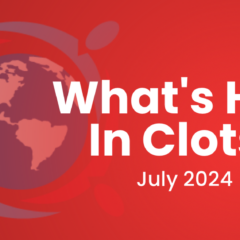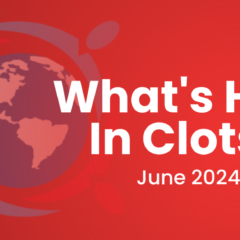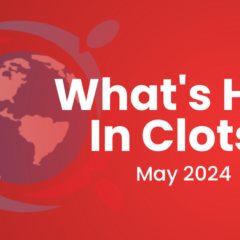Last updated on
What’s Hot in Clots – January 2024
Key Updates in Thrombosis
Table of Contents
- Dual antiplatelet therapy is beneficial within 72 hours of ischemic stroke from atherosclerosis
- High-risk pulmonary embolism (PE): Very deadly, although showing signs of progress over time
- Antithrombotic therapy in patients undergoing EP or interventional procedures
- Closing the highways: Developmental or procedural interruption of the vena cava
Happy New Year! Here are my top picks of the month:
Dual antiplatelet therapy is beneficial within 72 hours of ischemic stroke from atherosclerosis
Previous studies had shown that dual antiplatelet therapy initiated within 24 hours of ischemic stroke, compared with aspirin alone, led to a reduction in the risk of subsequent stroke at risk of a modest absolute increase in major bleeding events. Now, a large trial from China suggests that even if dual antiplatelet therapy is initiated within the first 72 hours, similar benefits are observed. Read more.
High-risk pulmonary embolism (PE): Very deadly, although showing signs of progress over time
A new report from the PERT registry discussed therapies and outcomes in patients with intermediate-risk PE and high-risk PE. One of the things that I found most interesting was that in-hospital mortality among high-risk patients was 20%. From one end, it is concerning to note that one in five patients with high-risk PE die in contemporary practice, and yet I find the numbers to be lower that what has been historically quoted in the literature. Read more.
Antithrombotic therapy in patients undergoing EP or interventional procedures
A new reviewer article summarizes thoughtful recommendations for antithrombotic therapy in patients undergoing electrophysiological (EP) or interventional procedures. The Central Illustration has practical suggestions for periprocedural management for many of these procedures, from simple electrical cardioversion to ablations for atrial or ventricular arrhythmia and percutaneous procedures for coronary or valvular diseases. Read more.
Closing the highways: Developmental or procedural interruption of the vena cava
The potential to reduce PE through procedural vena cava interruption has been considered since the 1860s. Initially done by morbid surgeries such as surgical ligation or partial ligation, these days percutaneous vena cava filtration is the most common method of vena cava interruption. In this paper, we provide a comprehensive systematic overview on the history and clinical evidence about the natural interruption of the venae cavae (such as agenesis or stenosis), and procedural interruption, namely IVC filters. We share data from current best evidence of safety and efficacy, recommendations from professional societies, and areas that need attention for future research. Read more.
For more updates, be sure to subscribe to get the latest updates each month.
Find this information helpful? Please consider making a small donation in support of thrombosis education & resources.

Behnood Bikdeli, MD, MS
Cardiologist, Section of Vascular Medicine, Division of Cardiovascular Medicine, Brigham and Women’s Hospital
Investigator, Thrombosis Research Group, Division of Cardiovascular Medicine, Brigham and Women’s Hospital
Instructor, Harvard Medical School
Investigator, Yale/ YNHH Center for Outcomes Research and Evaluation, Yale School of Medicine
Investigator, Cardiovascular Research Foundation



